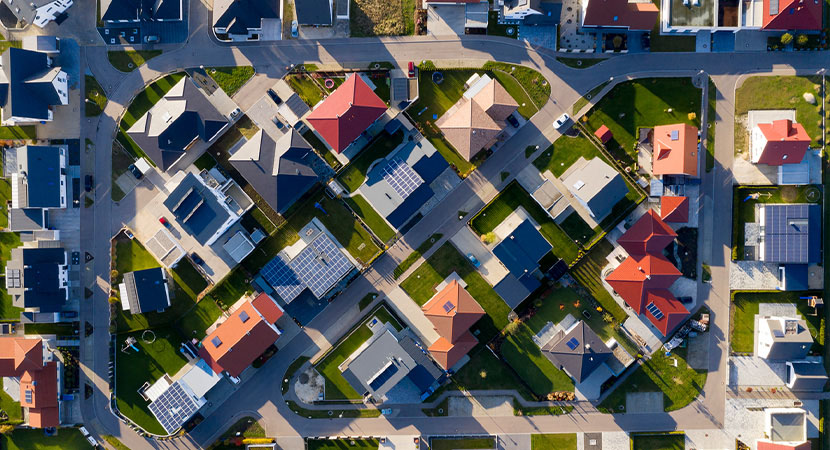Build-to-rent communities are growing all over the country thanks to strong demand from renters. In fact, there was a 106% increase in build-to-rent homes in 2022 compared to the previous year. Recent market dynamics have made these homes an ideal option for many renters. Since these communities are forecasted to be favorable long-term investments, investors are eager to add them to their portfolios.
How do build-to-rent communities differ from apartment communities?
Build-to-rent (BTR) communities are a hybrid between single-family homes and multifamily communities. These communities are professionally managed and give renters the space and privacy of a single-family home, along with the amenities and perks of multifamily living.
More indoor and outdoor space
Traditional single-family rentals are typically located in an area full of homeowners. However, BTR homes are situated in communities designed for renters. Sometimes referred to as “horizontal apartments,” these homes give residents more space from neighboring units.
On average, BTR residences offer between 200 to 600 square feet more than a traditional apartment. Additionally, it’s common for renters to receive other perks such as attached garages and yards that are regularly landscaped and/or fenced.
Higher rent
Added space typically commands higher rent than a standard apartment unit. But extra space isn’t the only factor in increasing prices. Residents are also willing to spend a little more on BTR communities with amenities like pools, dog parks, gyms, and clubhouses.
Less turnover
Renters also tend to stay in BTR homes longer than in apartments. According to the National Apartment Association, one company reported its annual turnover rate for build-to-rent communities hovered around 40%. This means that one of the advantages of managing a community is that fewer vacancies need to be filled.
Which renter demographics want build-to-rent communities?
Since BTR residences offer more space, they’re attractive to those with certain lifestyles. Forty-four percent of the build-to-rent market are couples with young children, making them the most prevalent demographic in these communities.
Having additional space is also attractive to people who spend most of their time at home, such as remote workers. During the COVID pandemic, interest in BTR communities began to rise. Today, remote and hybrid work schedules remain popular and renters are seeking homes that offer more space to set up home offices.
BTR homes are also a good fit for pet owners. In fact, it’s estimated that at least 70% of build-to-renters have pets! The convenience of having private outdoor space certainly makes life with an animal much easier.
What are best practices for managing build-to-rent communities?
BTR communities are a unique segment of the rental market—and accordingly—managing these properties is a little different than traditional apartments. Here are five best practices to simplify operations and cater to your renters’ needs.
1. Prioritize resident satisfaction
Resident satisfaction is key to a successful BTR community. Happy renters are more likely to renew their leases, recommend the community to others, and provide positive reviews online. Make sure that resident satisfaction is a top priority by responding quickly to maintenance requests, providing excellent customer service, and fostering a sense of community through events and other initiatives.
2. Invest in technology
Technology can be a game-changer when it comes to managing a BTR community. Consider investing in property management software that streamlines tenant communications, tracks maintenance requests, and automates rent collection. You should also consider smart home technology, which can make it easier for residents to control their living environments and reduce energy costs.
3. Create a sense of community
One of the benefits of BTR properties is the sense of community that can be fostered among residents. Encourage this by organizing on-site events, such as cookouts, game nights, or fitness classes. Create online forums or social media groups where residents can connect and share information as well.
4. Stay on top of maintenance
Maintenance is a critical aspect of managing a BTR community. Regular inspections and preventative maintenance can help resolve issues before they become bigger problems. Consider setting up a service schedule and prioritizing urgent requests. Make sure renters know how to report maintenance concerns and provide them with a clear timeline for when they can expect a resolution.
5. Be transparent with residents
Transparency is crucial to building trust with tenants. Make sure your residents are aware of the community’s rules and regulations, including any fees or penalties for breaking them. Be candid about any upcoming renovations or changes to the property that may impact them and communicate these changes in a clear and timely manner.
Ensure long-term success
Managing a build-to-rent community requires excellent customer service, cutting-edge technology, and a strong community. By prioritizing resident satisfaction, investing in technology, creating a sense of belonging, staying on top of maintenance, and being transparent with residents, you can effectively manage your BTR property and ensure long-term success.
Zego integrates seamlessly with Rent Manager to provide digital payments and utility management solutions for build-to-rent communities. Provide a better resident experience today with Zego.






